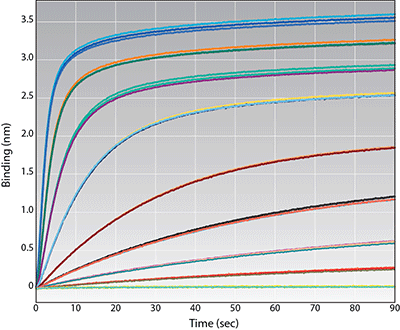For Label-Free Quantitation and Kinetic Analysis of His-Tagged Recombinant Proteins
The polyhistidine protein tag (His-tag), commonly engineered into proteins during cloning, can be used to facilitate recombinant protein purification and detection by exploiting the chelating properties of histidine to an immobilized metal. The Anti-Penta-HIS (HIS1K) Biosensor consists of high affinity, high specificity Penta-His antibody from Qiagen pre-immobilized on a fiber optic biosensor. In conjunction with the Octet® and BLItz® systems, the HIS1K Biosensor provides a rapid and label-free method for His-tagged protein quantitation and kinetic characterization. The high specificity of the antibody-based biosensor enables the direct capture and quantitation of His-tagged proteins even in crude cell lysates or supernatants.
Learn more:
Key Features
- High specificity and affinity to a six-histidine or penta-histidine peptide tag (His-tag)
- Designed for use in buffer, complex media, column eluates, and cell lysates
- Binds His-tagged proteins even in the presence of imidazole
- Direct capture of His-tagged proteins for kinetic analysis with interacting protein analyte
- Easy to use, label-free, no wash protocol

Figure 1: Detection of His-PAI1 (43 kDa) protein standards (n=3) using Anti-Penta-HIS biosensors on the Octet RED384 system.

Figure 2: Kinetic analysis of the interaction between ligand His-tagged Rat C-Reactive Protein (24 kDa) and analyte Mouse Anti-Rat C-Reactive Protein (150 kDa). 10X Kinetics Buffer was used as the matrix throughout and the assay temperature was 30°C. Data were processed and fitted using a 1:1 binding model (curve fit lines in red).
For More Information
Visit our literature page to download technical notes, application notes, posters and customer presentations.